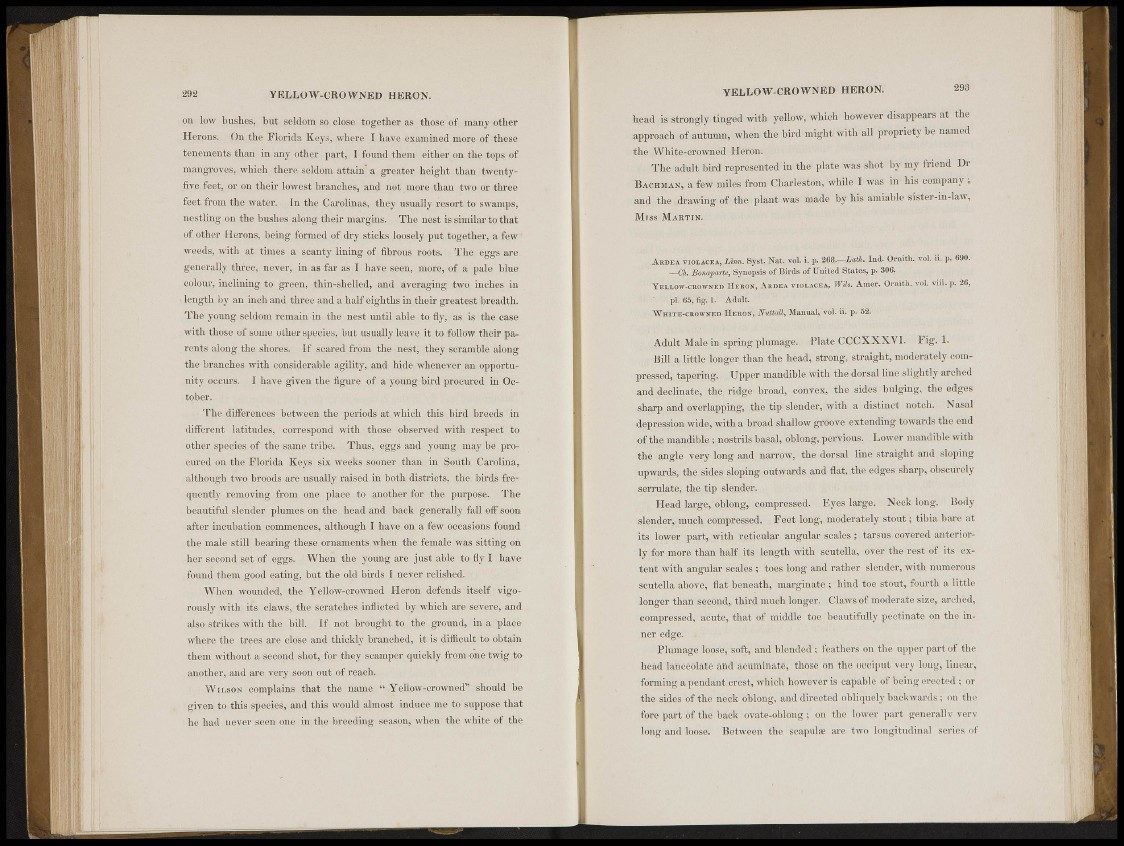
292 Y E L L O W - C R O W N E D HERON.
»•i fer iltíiifsj but seldom so clQge together as (hose ol' many other
I lei:,Oils. On the Florida Keys, where I have esamini«! more of these
tenements than in any,other part, I found them either on the Tops of
mangroves,, which thorn seldom attain' a greater height than twentyjlpltfeet,
" r on their lowest branches, and not more than two or three
feet,from tho water. In the Carolinas, they usually resort to swamp,
pestling on the hushes, along their margins», The nest is similar to that
of other Herons, being formed of dry sticks¡J§¡JS¡Sty put together. a few •
tvoeds, with at times a: scanty lining of fibrous roots. The eggs are.
generally three, nevur, in as fax as I have s.e(m, more, oi' a pale blue
colour, inclining to green, Uiin-shelled, and averaging two inches in
- length by an inch and three and a half eighths in their greatest breadth.
The young seldom remain in the nest until able to iiv, as is the case
. with those of some other specios, hut usually leave it to follow their parents
along the shores. If scared from tho nest, they scramble along
the branches with considerable agility, and hide whenever an opportunity
occurs. I have, given the iiguro of a young bird procured in Oc-
.tober.
, i The differentia between the periods at which this bird breeds in
different latitudes. Correspond with those observed -with respect to
other species.-of the santo tribe. Thus, --.ei;gi> and young may bé procured
on the Florida Keys six weeKs sooner thanjiYi South (Carolina,
although two broods aré usually raised in both districts, the birds frequently
removing from one place to another for the purpose. The
beautiful slender plumes on thè head and bach generally fall olì' soon
after incubation commences, although I have on a few occasions found
thè; male still bearing these; ornaments when the female was sitting on
Sgor second sot of eggs. When the young are just able to fly I have
found them good eating, but the ,§M birds I never relished.
When wounded, the Yellovv-crowne.il Heron defends itself vigorously
with its claws, the s,cratches inflicted by which arc sojfero, and
also strikes with the bill. If not ¡brought to the ground, in a "piaci
where the trees are close and thickly branched, it is difìicult to obtain
them without a second shot,, for they scamper quickly from one twig to
a n o t h « and are very soon out of reach.
WILSON complains that the ñame " .Y eHow-crowncd"' should be
give» to this species, and this would almost induce me t» suppose that
he had never seen one in the breeding season, when the white of the
Y E L L O W - C R O W N E D HERON. 298
head is strongly tinged with yellow, which however disappears at the'
appoach of autumn, when the bird might with |gj propriety be named
the White-crowned Heron.
The adult bird represented in the plate was shot by my friend l)r
BACHMAS,;"h low miles from Charleston, whi lst was in his -company ;
and the .drawing of the plant was made by his amiable sister-in-law,
Miss MARTIN.
ASDEA VIOI-ACEA, Linn Syst,,Nat vol I p. 268 —Laik Ind. Dmi t l i . '«! M,pj.690.
—bL Bonaparte, synopsis of liirds of I.'nited States, p. 306.
Yt:i.unr-CHOWSi:n IIKHOX, AHHKA VIOIAOEA, W3S. Amor. Ornibli. voL viii. p, 26,
' ' - pi;l65jSg,.'l. ¿tâaït.
WijiTK-tfinwsKii 3It:RON. X-dttoii. Manual, Vol. ii. p. 52.
Adult Male in spring plumage. Plate CCCX.X XVI. Fig. 1.
Hill a little longer than the head, strong, straight,,moderately compressed,
tapering.;. Upper mandible with the: dorsal lincslightly arched
and déclinait!, -the ridge broad, convex, the sides bulging, the edges
sharp and overlapping, the tip slender, with a distinct notch.- Nasal
depression wide, with a broad shallow groove extending towards the end
of tho mandible nostrils basal, oblong, pervious. Lower mandible with
the angle very long and narrow, the dorsal line straight and sloping
upwards, the sides sloping outwards and flat, the edges- sharp, obscurely
serrulate, the tip slender.
Head, large, oblong, compressed. : Eyes large. Neck long. Body
slender, much compressed. Feet long, moderately stout- ; tibia bare at
its tower part, with reticular angular scales- tarsus, covered anteriorly
for-more than half its .length with seutella, over tho rest of its extent
with angular scales ; toes long and rather slender, with numerous
seutella above, flat beneath, marginale ; hind toe stout, fourth a little
longer than second,, third much longer. Claws of moderate size, arched,
compressed, acute, that of middle toe beautifully pectinate on the inner
edge. '
Plumage loose, soft, and blended ; feathers on the upper part of the
head lanceolate and acuminate, those On the occiput very long, linear,
forming a pendant crest, which however is capable of being erected ; or
the sides of the meek oblong, and directed obliquely backwards ; on the
fore part of the back ovate-oblong ; on the lower part generally very
long and loose. Between the scapulae are two longitudinal series of